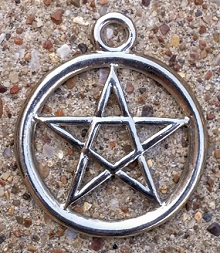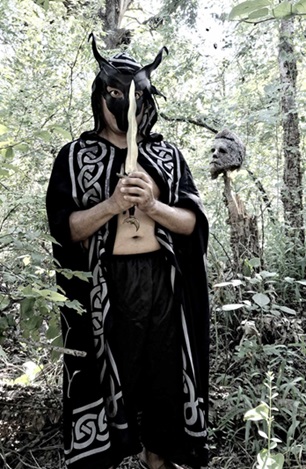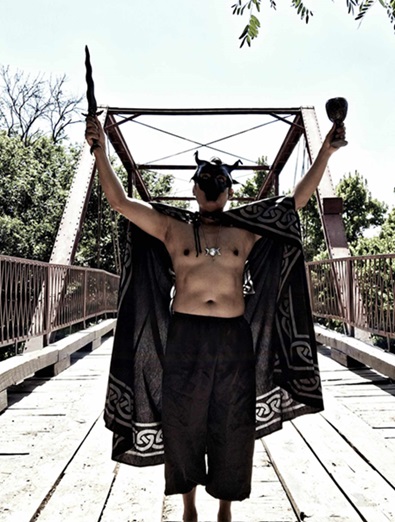Subject: priest / witch
Culture: Wiccan/Neo-Pagan
Setting: America, Europe
Evolution:
Context (Event Photos, Primary Sources, Secondary Sources, Field Notes)
* Harvey 1997 p35-36
"Of all the varieties of Paganism it is Witchcraft -- the Witches' Craft -- which receives most media attention. More words are written or spoken about Witches than about any other group. Not a few of these words are written or spoken by Witches themselves. Despite all these words the popular image -- or is it the media image? -- is mostly inaccurate. Terry Pratchett summarises this image as 'dancing around naked', 'all that business with goat-headed gods', 'the bits of reptile and so on', 'mystic ointments' and 'sabbats'. He does not say that the prevalent idea of a Witch is of an elderly and wicked woman practising 'black magic' against neighbours and their property. This sinister image is, of course, a more exciting one than that presented by those who, in the present, call themselves Witches. It is also an ancient image, one that is easily evoked and not easily dismissed.
"[...] The name 'Wicca' is preferred to the words 'Witch' or 'Witchcraft' by some Pagans, especially those initiated in British Gardnerian and Alexandrian covens. Perhaps because of the association with these more closed traditions, others dislike the label 'Wicca'. In North America 'Wicca' is used more widely as a synonym of 'Witch' or 'adherent of the Craft' without distinguishing between traditions. ... Note too that male Witches are also 'Witches' -- terms like 'warlock' and 'wizard' have been rejected by contemporary Pagans."
Dagger
* Hutton 1999 p229-230 (describing Gerald Gardner's system)
"The principal working tool ... is ... the black-handled knife, and this is another major innovation as the supremacy of this instrument is found neither in the Golden Dawn and Crowley traditions nor in the Key of Solomon. In 'Ye Bok of ye Art Magical' (and later Book of Shadows) it is termed 'the true Witch's weapon', having in concentrated form all the power of the more traditional dominant consecrated sword, to form magical circles and control spirits. 'Ye Bok' also gives the name by which it was to become central to modern pagan witchcraft, of 'athame' (conventionally pronounced 'athaymee'). This is derived from the Key of Solomon, but only in a few recensions of the work. The markings to be placed upon the handle when the knife is consecrated are taken from the Mathers edition of the work along with so much other material in 'Ye Bok', but the name 'athame' does not appear in that edition.
"The problem with the Key, as Mathers discovered, is that it is not a standard text, but a framework for ritual within which various copyists in the sixteenth to eighteenth centuries added or mutated details. Mathers compiled his 'standard' text by conflating seven different versions in the British Museum. The number and functions of the ritual weapons varies significantly between these, and only one of them gives the black-handled knife a name (which Mathers ignored), of arclavo or arclavum. There is, however, an eighth manuscript in the same collection, which Mathers did not notice, and this provides the terms arthanus or artamus for the instrument; the white-handled equivalent is the arthany. In the Bibliotheque de l'Arsenal, Paris, is yet another, and here the word for the black-handled knife is arthame, which is closest to Gardner's version. There is no evidence that Gardner consulted any of these manuscripts, but he was an avid reader of modern works on the occult, and two in the early twentieth century published details of the last pair cited above: C.J.S. Thompson's The Mysteries and Secrets of Magic (1927) used the terms from the London manuscript, and Grillot de Givry's Witchcraft, Magic and Alchemy (1931) prominently cited the Paris text, including a fine photograph of a page of it describing the arthame. The American fantasy writer Clark Ashton Smith copied de Givry's information to make the arthame feature prominently in a short story, 'The Master of the Crabs', published by the magazine Weird Tales in 1947, when Gardner was in America. The origins of the term are not known; perhaps the simplest and most likely source is that proposed by James Baker: the Old French verbe attame, meaning 'to cut'. There is no evidence to explain Gardner's omission of the 'r' in the word; perhaps he first heard it orally and guessed at the spelling, perhaps he decided to simplify it, or perhaps the error was in a source which he was copying.
"None of this, however, accounts for why this knife becomes 'the true Witch's weapon'. Two explanations may be proposed, which are entirely compatible. One is that the black-handled knife is a powerful magical weapon in Irish folk tradition, employed to banish malevolent fairies and other unwelcome spirits. As a prominent member of the Folk-Lore Society, Gardner may well have come across these stories. The second is that he himself had a preoccupation with ritual knives, of which he had collected scores, and in particular with the Malay kris, upon which he was one of the world's experts. It may have been he who decided to make such a knife, with a distinctive name parallel to that of the kris, the indispensable ceremonial tool of the witch religion which he was to publicize."
* Cunningham 2001 p109-110
"El athame (cuchillo de ritual) usualmente tiene mango negro con una hoja de acero que puede ser de filo doble o sencillo. El athame (tiene otros nombres pero Este es el más común) nunca es usado con el propósito de cortar, ni para hacer sacrificios. El cuchillo es un instrumento de poder utilizado para dirigir la energía natural que está dentro del cuerpo hacia el mundo exterior. Aunque los mecanismos son diferentes en algunas tradiciones, este cuchillo es considerado como algo sagrado en relación con el dios.
"Una espada, la cual es sólo una versión más larga del cuchillo, puede ser usada en su lugal pero generalmente se utiliza para desarrollar los trabajos de las congregaciones."
* Adler 1986 p109
"Craft ritual usually starts with casting and creating this magical space [the Wiccan circle] and ritually purifying it with the ancient elements: fire, water, earth, and air. The circle is cast with a ritual sword, wand, or athame (a small, usually black-handled and double-bladed [NOTE: Probably meaning 'double-edged'] dagger that is used by almost all covens, whatever their tradition). Different covens have different symbologies, but often the sword represents fire, the wand (or incense burner) air, the cup water, and the pentacle -- a round, inscribed disk of wax or metal -- earth. When the circle is cast, often the gods and goddesses are invoked."
* Clifton ed. 1992 p54-55 (Pauline Campanelli, "Seasonal Rites/Magical Rites" p53-67, describing a seasonal ritual)
"Once all is ready the priestess and priest enter the circle. One of them may signal the ritual's beginning by ringing a clear-toned bell. The priestess then begins by placing her athame's point into the bowl of water and saying words like:
"Then the priest purifies the salt by placing his athame's point in it and saying words like:
"He then pours some salt into the water.
"Taking her athame or the ritual sword, the priestess draws the circle with its point to the floor, moving sunwise (clockwise or 'deosil') from the northern point. Coveners have been waiting outside the circle at the eastern point; now the priestess makes a 'doorway' by raising the athame to the height of a person, drawing it across for two or three feet and then back down to the floor. As she inscribes the circle she and the coveners visualize a bright blue flame emanating from the athame's point and making the circle."
Cup
* Cunningham 2001 p112
"La copa o el cáliz es otro símbolo de la diosa y es simplemente una vasija sobre un soporte; puede contener vino o agua y se bebe en los rituales. No es parodia del cristianismo. La copa tiene tanta o poca conexión con el soporte usado en la santa comunión como lo tiene el caldero."
* Adler 1986 p168
"Most covens ... have a ceremony of 'cakes and wine,' during which the ritual dagger or athame is lowered into the cup and the cakes and the wine are consecrated."
* Harvey 1997 p48
"The actual communion of cakes and wine may be ritualised or it may be very simple. In Wicca a priest holds the cup of wine, symbol of the Goddess, into which a priestess dips a ceremonial knife called an athame, a symbol of the God. For some this symbolises intimacy between Goddess and God, men and women, masculine and feminine. For others it shows that 'the two divine forces are ultimately reconciled in One'. All drink from the cup and then share blessed cakes, sometimes in the shape of the crescent moon. Alternatively and more simply, the food and drink allow a more complete 'earthing' and a brief time to express gratitude for the results of previous 'work'."
Costume
*
"
Jewelry
*
"





